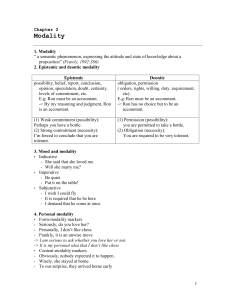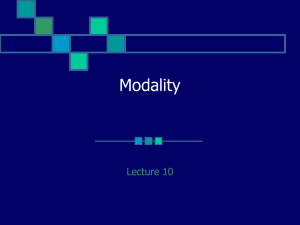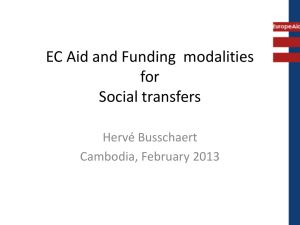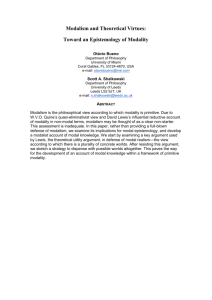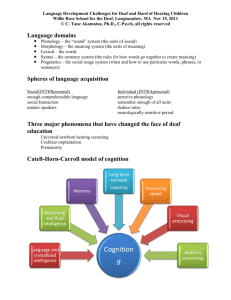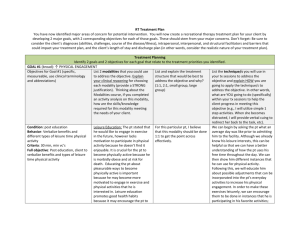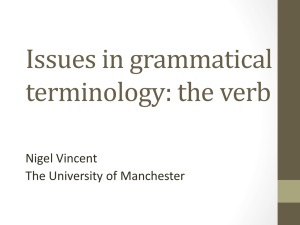11a Modality
advertisement
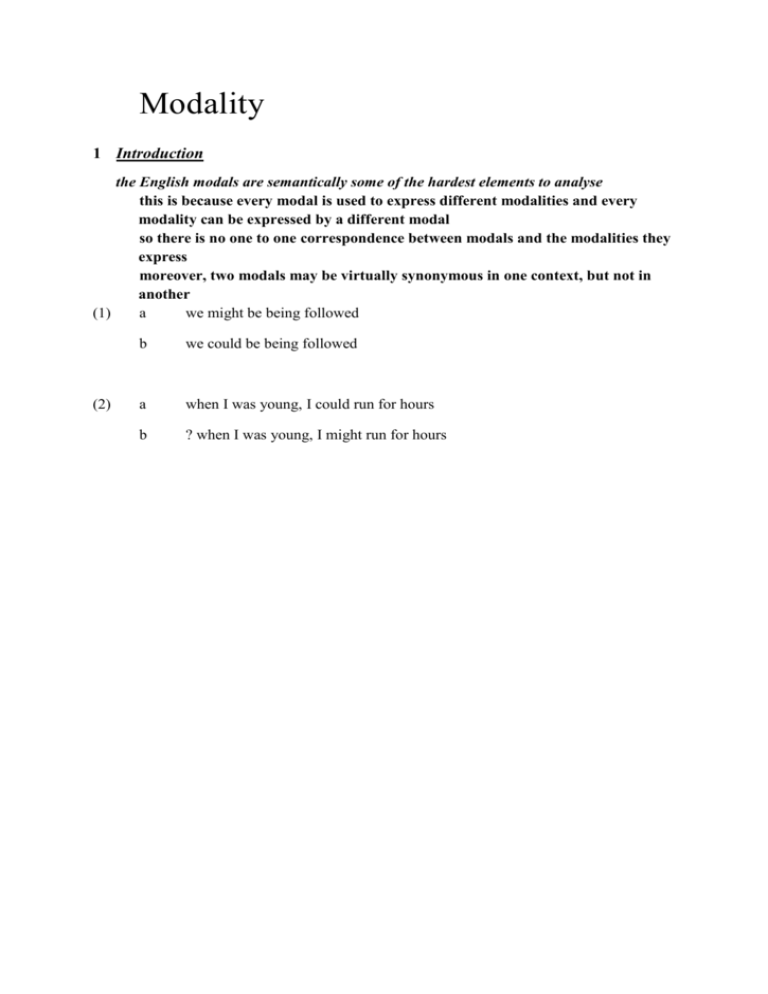
Modality 1 Introduction the English modals are semantically some of the hardest elements to analyse this is because every modal is used to express different modalities and every modality can be expressed by a different modal so there is no one to one correspondence between modals and the modalities they express moreover, two modals may be virtually synonymous in one context, but not in another (1) a we might be being followed (2) b we could be being followed a when I was young, I could run for hours b ? when I was young, I might run for hours it is clear therefore that we cannot simply associate modals with a particular modality or set of modalities in any simple way 2 Modality before we start to look at how modals are used to express modality, it is first necessary to analyse modality itself – this is a complicated thing in itself it is traditional to classify modalities into at least two types epistemic modality which has to do with the logical relations of possibility and necessity a triangle must have 3 sides a triangle may have one 90 angle root modality i.e. all the rest you must go to gaol I can see your house from here 3 epistemic modality is not only used to express logical relations, but also conclusions based on what is known (hence ‘epistemic’) working here must be boring he may be in his office these do not involve logical necessity and possibility, but conclude on the basis of what is known knowing what the work entails and knowing what sorts of things are boring, I conclude that in all possible worlds in which these are held constant, it is boring working here knowing all that I do about the person involved, I conclude that in at least some possible world in which this is held constant, he is in his office however, English does not seem to distinguish between logical and epistemic necessity and possibility in that exactly the same modals are used to express both. therefore we don’t need to separate these as different types 4 root modality is more differentiated it includes Deontic modality (concerning obligation and permission) and notions of ability and volition you should go to the dentist (obligation) you may go in now (permission) I can ride a unicycle (ability) he will sell me his ticket (volition) Palmer argues that these are distinct because ability and volition can be expressed with a tense distinction, but obligation and permission cannot I could ride a unicycle = past of I can ride a unicycle He would sell me a ticket = past of he will sell me a ticket you should know past of you shall know you might go in past of you may go in past time reference can be expressed separately (with a perfect) with Deontic modals, but not the others you should have gone to the dentist you may have left at any time * can have played the tuba * he will have lent me the money they interact with negation differently must (deon) vs. can (abl) you mustn’t leave you are obliged not to leave (MOD > NEG) you must not leave you are obliged not to leave I can’t leave I don’t have the ability to leave (NEG > MOD) I can not leave ??? I have the ability not to leave (MOD > NEG) can (deon) vs. will (vol) you can’t leave you don’t have permission to leave (NEG > MOD)= you are obliged to stay you can not leave you have permission not to leave (MOD > NEG)= you are not obliged to stay he won’t leave he isn’t willing to leave (NEG > MOD) he is able to stay he will not leave ??? he is willing to not leave (MOD > NEG) he is not able to stay 5 Therefore Palmer concludes that there are three different types of modality epistemic Deontic dynamic by this he means to indicate ‘power’, but while this is the Greek term, as are epistemic (= knowledge) and Deontic (= obligatory), but in modern English this meaning has shifted (more to do with movement) and it is also used as a term for a type of verb (dynamic vs. stative). For these reasons I prefer potential this is Latin for ‘power’ 6 Degree of Modality traditionally, the difference between necessity and possibility is seen as a second axis along which we differentiate modals Palmer calls this the degree of modality however, while this terminology implies that this distinction is only relevant for epistemic modality, the fact is that all modalities show distinctions epistemic necessity possibility Deontic obligation permission potential willingness ability though these notions don’t seem to have much to do with each other, it might be argued that they relate to the same thing for one thing, there are two notions associated with each modal type moreover, a similar relationship exists between them if something is necessary then it is possible, but not vice versa obligation is compatible with permission, but not vice versa willingness is compatible with ability, but not vice versa finally, there are modals which express different types of modality, and when they do they always express the same degree: must (ep) necessity must (deon) obligation may (ep) possibility may (deon) permission can (deon) permission can (pot) ability will (ep) necessity will (pot) willingness this would suggest that there is some feature which these modals express which is constant across the different types of modality that they are associated with +F = must, will -F = may, can Kratzer 1977 gives a semantic analysis of this aspect of modality which suggests that degree is uniform across all modal types. In her analysis of must and can she takes type of modality to be provided by a separate argument of the modal must in view of – what is known must in view of – what duties there are can in view of – what is known can in view of – what duties there are it would be too complicated to go into her semantic theory here, but the essentials are that ‘must in view of’ and ‘can in view of’ are defined uniformly must in view of logically follows from the set of propositions provided by the second argument (what is known, what duties there are) can in view of is compatible with the set of propositions provided by the second argument a proposition logically follows from a set of propositions if there is no possible world in which the set of propositions is true and the proposition is false a proposition is compatible with a set of propositions if there is some possible world in which the set is true and the proposition is true However degree is to be formally defined, I will assume two features to express it: [ff] = follows from [cw] = compatible with 7 Finally there is one more dimension to modality that we need to acknowledge most modals come in pairs can/could, may/might, shall/should, will/would while these derive from the tense forms of the corresponding verbs in Old English, they mostly have nothing to do with tense (except for the potential modalities) instead they seem to denote degrees of certainty of a proposition he may be in his office he might be in his office this reflects what might be called evidentiality – the nature of evidence we have for believing something sometimes this distinction is expressed by different modals you must write an essay you should write an essay I will assume a further two features to express this distinction [ev] = high evidentiality [ev] = low evidentiality 8 Conclusion the features of modality I will adopt are: type: [ep], [deon]. [pot] degree: [ff], [cw] evidentiality: [ev], [ev]
